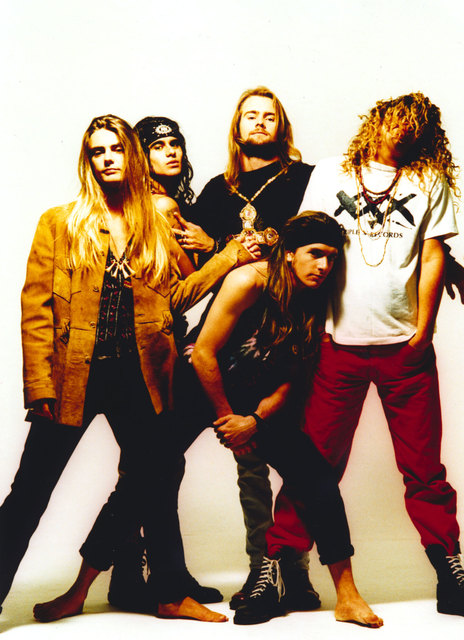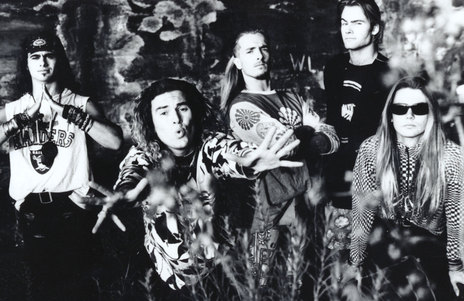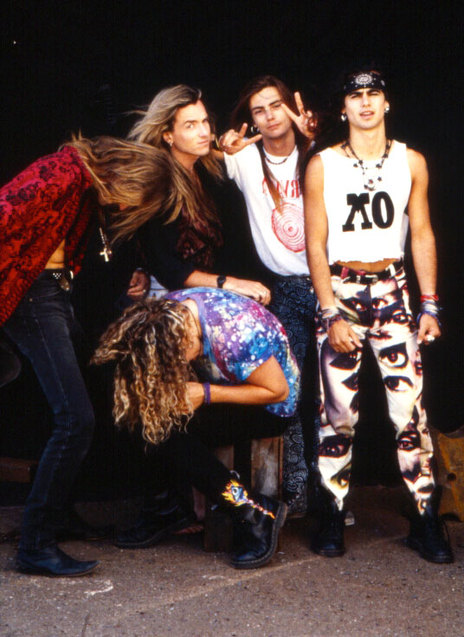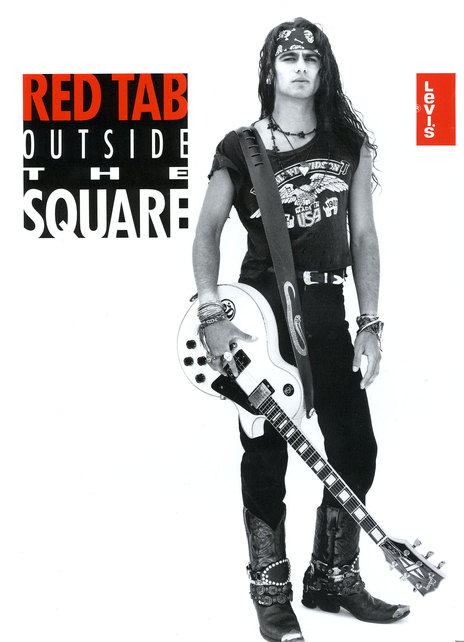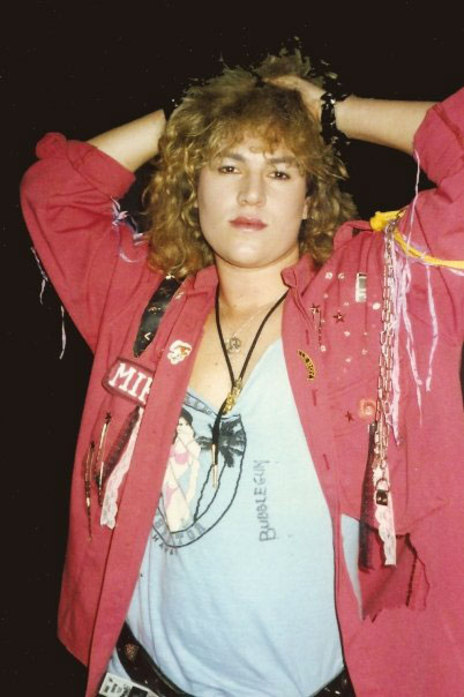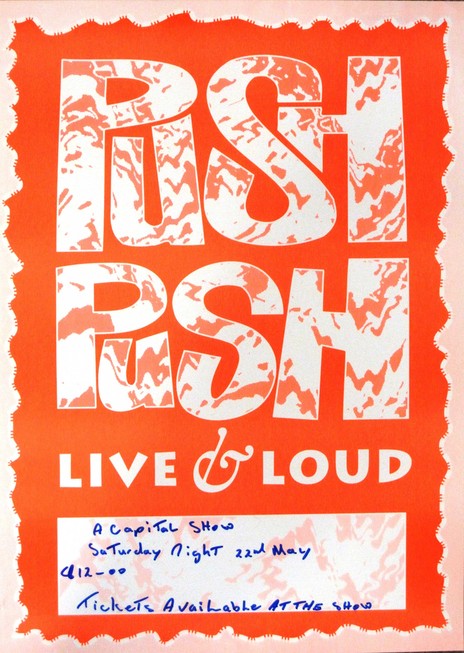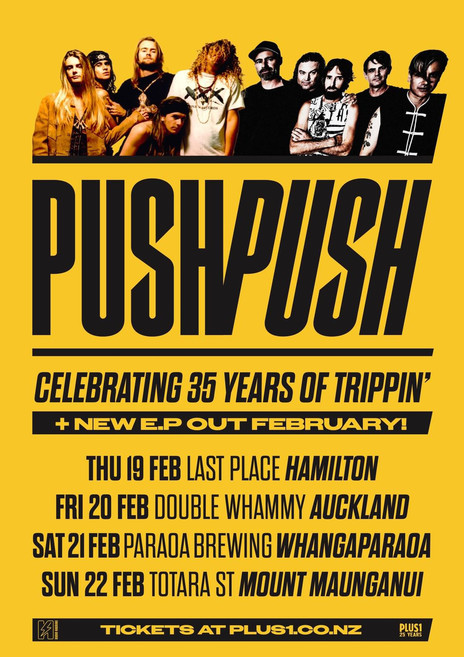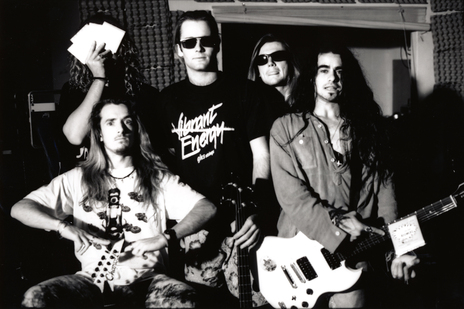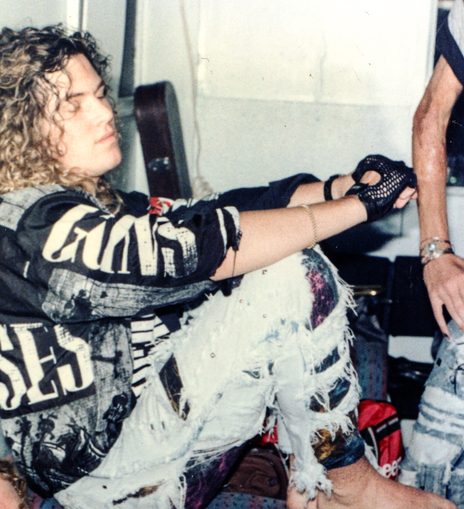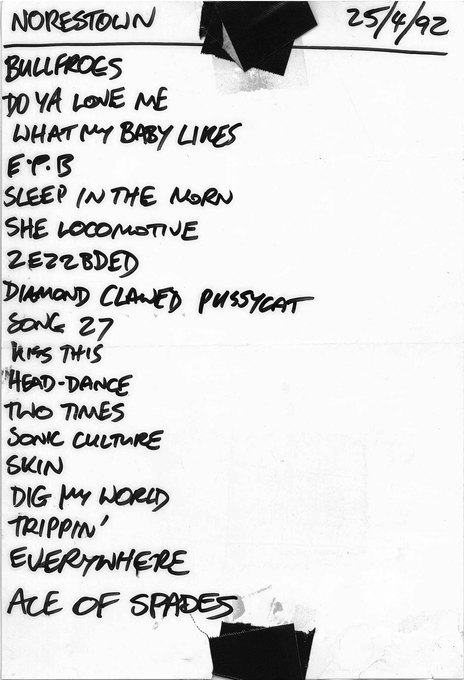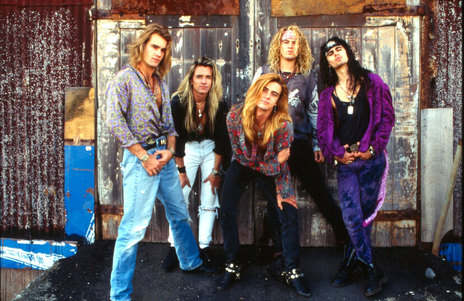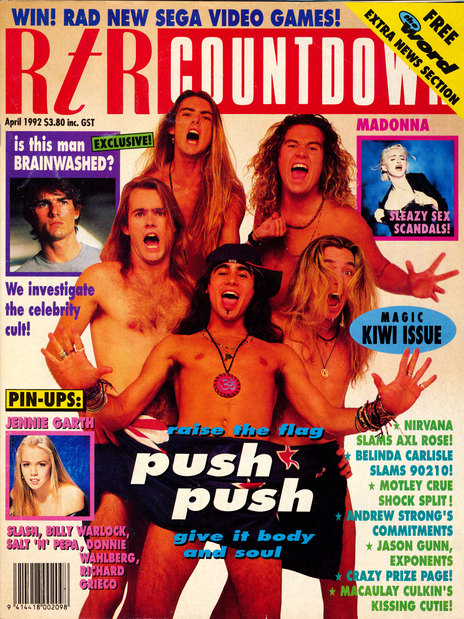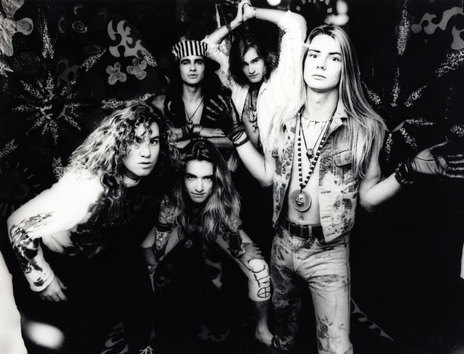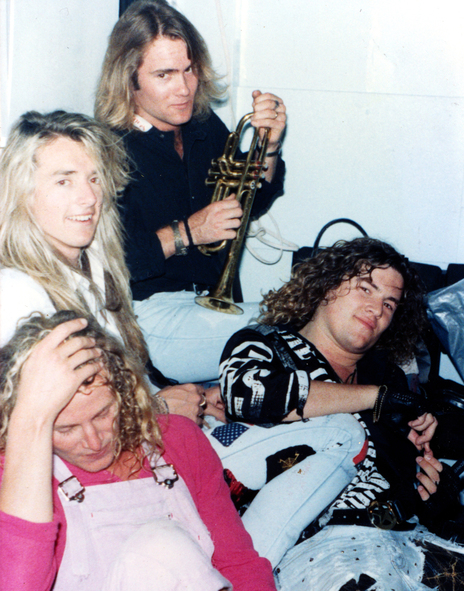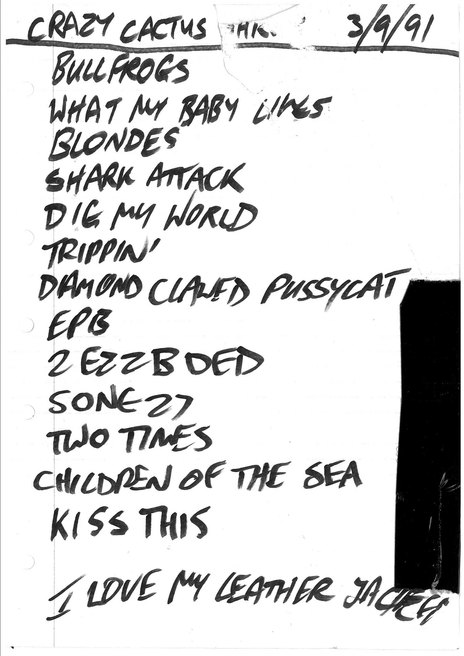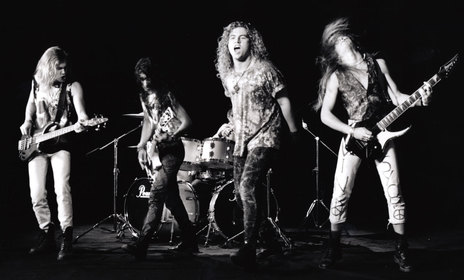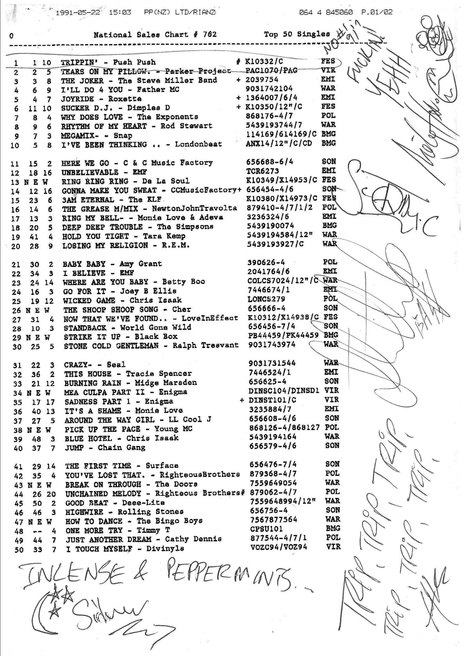But who could ignore Push Push’s youthful colour and energy, Chris and Tim Mauger’s ‘Trippin’’ video, and the simple immediacy of the song with its “I was trippin’ out on you” refrain?
The band first emerged in the mid-1980s, from the sun, surf, and parties of Auckland’s North Shore. Vocalist Mikey Havoc, guitarist Andy Kane, bassist Steve Abplanalp, and drummer Ken Green were students at Rangitoto College, obsessed with everything loud and vivid.
Motley Crue, Iron Maiden, Guns ‘N Roses, Van Halen, Poison, and Motorhead were amongst the 1980s heavy metal icons whose names were penned on the nascent Push Push members’ schoolbags.
Havoc and Kane appeared in the glossy RTR Countdown magazine, looking the picture of LA glam rock excess.
In the late 1980s Havoc and Kane appeared in the glossy RTR Countdown magazine, looking the picture of LA glam rock excess – big hair, leopard stripe clothing, acid green Flying V guitar, jewellery, attitude to burn.
Around the same time they had their first exposure on national television, performing their song ‘TV Blue’ on the afterschool programme 3.45 Live.
When quizzed by presenter Rikki Morris as to the lure of playing loud rock, Kane was unequivocal.
“It makes your blood pump,” he stated. “All you want to do is just get up and rock and roll.”
That approach didn’t changed markedly as 1991 dawned, although levels of nuance were entering the world of Push Push.
There were line-up changes that saw rhythm guitarist Shayne Silver recruited, and ex-Whiskey and Lace member Scott Cortese replace Green on the drum stool.
Subtle musical changes were in the wind too, as a raft of exciting new influences came to bear. These included contemporary American rock acts like the Red Hot Chili Peppers, Jane's Addiction, Fishbone, Faith No More, and the wave of Seattle bands including Nirvana, Pearl Jam forerunner Mother Love Bone, and Soundgarden.
“I don’t regret teasing our hair and wearing lycra because at the time we were the only ones doing it,” Havoc told RipItUp in 1992. “But since then I’ve found I enjoy all sorts of music, but I really enjoy a few bands and I want to keep discovering new ones.”
Mother Love Bone in particular were a potent force in the direction Push Push took as their star rose. Havoc took a cue from their late vocalist Andrew Wood in the way he embraced the stage and the demands of popularity. And the cosmic, neon flower child aesthetic of the Seattle band certainly inspired the look and feel of Push Push.
Silver also played a hand in this, in his self-appointed role as the band’s stylist. He created many of the vibrant hand-painted clothes that they wore, and selected pieces from cutting edge Auckland clothing labels such as Virus, and Joy.
The band built a strong following through the infamous Five Bands for Five Bucks nights at the Powerstation in central Auckland.
The band built a strong following through the infamous Five Bands for Five Bucks nights at the Powerstation in central Auckland. Amongst their peers were fellow heavy rockers Nine Livez, Circus, My World Crazy, Bad Boy Lollipop, and Whiskey and Lace.
Some would fade away as the more prosaic grunge form eclipsed hair metal, while others morphed into the likes of Dead Flowers.
With manager Steve Morice and producer Tim Foreman from Airforce Recording Studio onboard, the Push Push quintet devised a plan. This included forming their own record label, Tall Poppy, due to lack of interest from the major labels. Festival Records would act as distributor.
‘Trippin’’ was the first fruit of this endeavour. The song’s forthright, almost punkish attitude, revolving on a beautifully moronic riff, couldn’t have been any timelier. It provided a bridge between the band’s extravagant glam metal beginnings and their reach towards something more esoteric.
In simple terms, it was a refreshing blast of wild adolescent energy, in the same way The Who’s ‘My Generation’ or the Ramones' ‘Blitzkrieg Bop’ had been.
And although New Zealand music hadn’t yet been embraced by the masses, things were beginning to change. As the 1990s unfolded there was a broadening awareness and understanding of locally created fare, and Push Push was at the vanguard.
The success of ‘Trippin’’ saw the band catapulted into the public arena.
The success of ‘Trippin’’ saw the band catapulted into the public arena, but even in their early 20s they were clearly equipped to deal with being a phenomenon. Indeed, the members took to touring in New Zealand like naturals, enjoying the dubious benefits on offer.
On those national excursions in 1991 Push Push was a powerful force, with a potent set list. Amongst the repertoire were later singles ‘Song 27’ and ‘What My Baby Likes’, along with covers of Split Enz’ ‘Shark Attack’, Black Sabbath’s ‘Children of the Sea’ and The Chills’ ‘I Love My Leather Jacket’.
They performed with bands from a diverse range of musical styles, including MC OJ and Rhythm Slave, the Hallelujah Picassos, These Wilding Ways, and even selected young support bands from the regions they visited.
However most were blown away by the main act, with the animated Havoc leading the charge. His energy was supported by the musicians behind him, who had honed their chops in front of Auckland’s demanding audiences.
“It comes down to that adrenalin thing,” Havoc said in 1992. “I’m in a band for the whole rush thing. When we write songs, we write them with all the highs in it, and it’s like as soon as you’re on stage, you hear the guitars go BOOOOOM! and you’re away.”
Arriving a few months after the success of ‘Trippin’’, second single ‘Song 27’ exhibited an entirely different aspect of Push Push. It was an accomplished, ambitious rock epic with its far more mature, searching, lyrical outlook.
I gotta find something like
The clear light of day
Rich, thick with substance
Got my will
Where’s my way?
‘Song 27’, which peaked at No.7 in the New Zealand charts, gave an indication of what the band would ultimately offer in the form of an album in early 1992.
Before that though, Push Push had to ride the success of ‘Trippin’’. That included following up on the single’s modest success in Australia, where it reached No.25.
Amongst their commitments across the Tasman during June 1991 was a much sought after slot on the extremely popular Hey Hey It’s Saturday TV show. Asked to mime, the band chose to play live.
Although the performance was as animated as ever, unfortunately a guitar was badly out of tune and so the overall effect was less than convincing.
Regardless, Australian rock icon Molly Meldrum stated on the show that “I think they’re one of the most exciting groups I’ve ever seen since AC/DC.”
Back at home, Push Push headed into Airforce Studio on Auckland’s Minnie Street in Eden Terrace to record their album, A Trillion Shades of Happy.
The recordings were done in a relatively quick and business-like manner, with Kane and Foreman co-producing.
A Trillion Shades of Happy clearly exhibited the various strengths of Push Push, from big, hooky, riff rock, to milder, more psychedelic moments.
They augmented ‘Trippin’’, ‘Song 27’ and its B-side ‘Do Ya Love Me?’ with seven more tracks. Amongst them were effervescent third single ‘What My Baby Likes’, the introspective ‘Dig My World’ with Jan Hellriegel on backing vocals, and the Andrew Wood tribute ‘2EZ2BDED’.
A Trillion Shades of Happy clearly exhibited the various strengths of Push Push, from big, hooky, riff rock, to milder, more psychedelic moments.
Fittingly, the limited edition 1,000 LPs were pressed on ‘tie-dyed’ multicoloured vinyl.
‘What My Baby Likes’ reached No.4 in the New Zealand charts, while Trillion Shades made it to No.3.
Despite their success, they were the last Push Push recordings to be released.
The band continued national touring throughout 1992, including with the resurgent Exponents. They wrote new songs, such as ‘Sleep in the Morning’, ‘Changes’ and ‘Desert Road’ – and even recorded some of them.
Although they won the ‘Best Group’ category at the 1992 New Zealand Music Awards, Push Push was heading into decline. Havoc was increasingly interested in other things, such as his burgeoning DJ career, while some in the band were hungry for international success.
There were advanced plans for them to make the move to conquer Australia – so advanced that Kane and Silver had already relocated. On the day Havoc was supposed to fly out he informed the rest of the band that he wouldn’t be making the move.
The remaining quartet attempted to keep Push Push going in Australia, and half-heartedly looked for a replacement vocalist. However they soon realised the endeavour would never recapture the same spirit.
That was it for Push Push. Kane and Silver stayed in Australia, and kept playing music in new band GTO, whose 2001 single ‘Superstars of Modern Love’ reached No.92 on the Australian charts.
Meanwhile Havoc forged a successful career in Auckland, initially as a DJ and club owner, and later in radio and television. His programme Havoc, with sidekick Jeremy “Newsboy” Wells introduced a refreshingly irreverent humour to New Zealand screens.
After a quiet period, he now hosts Havoc Nights on Radio Hauraki. Cortese and Abplanalp are also living in Auckland, and there have been requests for a Push Push reunion from a Facebook appreciation group.
